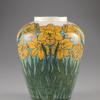Museum of Fine Arts Boston Acquires Work By Frida Kahlo
- BOSTON, Massachusetts
- /
- January 27, 2016
First Work by the Artist to Enter the MFA’s Collection; First Kahlo in a New England Museum Collection.
The Museum of Fine Arts, Boston (MFA), has acquired Dos Mujeres (Salvadora y Herminia) (1928) by Frida Kahlo (1907–1954). The painting depicts two Mexican women set against dense tropical foliage. Held privately in the United States since 1929—when it was purchased directly from the artist—the portrait was the first painting ever sold by Kahlo. It is now the first work by the artist to enter the Museum’s collection.
“The painting presents the dignified likeness of two maids, whom the artist had known since childhood. This major work will enable the Museum to tell the story of modernism in the Americas more broadly and inclusively, greatly enhancing its Art of the Americas collection. Rarely on view before now, it is the first Kahlo painting acquired by any museum in New England, and one of a select few by the artist to have entered a public collection in the US,” said Matthew Teitelbaum, Ann and Graham Gund Director at the MFA. “Frida Kahlo’s work is a 20th-century touchstone, and we’re proud to be able to count this remarkable acquisition among the MFA’s masterpieces of art of the Americas. As our community continues to grow and evolve, we’re committed to representing the diverse experiences of artists in our galleries.”
The work will be on view from January 27-March 1, 2016 in a special presentation in the Carol Vance Wall Rotunda. After conservation treatment, it will be re-installed in the Art of the Americas Wing later this year.
Dos Mujeres depicts two women, Salvadora and Herminia, who were maids in Kahlo’s mother’s household, the Casa Azul (Blue House). The subtle differentiation of their features and skin tones indicates pride in the diversity of the Mexican population, while the careful rendering of the figures and leafy background acknowledges Kahlo’s knowledge of both art history and contemporary realism. Remarkable in its graphic power, the painting’s heroic iconography of two workers is in keeping with Kahlo’s Communist sympathies. An early and intimate image, it displays Kahlo’s intent to capture Salvadora and Herminia as individuals, editing out their aprons and other such details as she painted.
The reverse side of the canvas also tells a story. Inscribed by the artist and various friends, signatures marking the sale of the work include that of painter Diego Rivera—who would become Kahlo’s husband just one month after the painting was sold. The work was acquired by Jackson Cole Phillips in 1929. He was an American industrialist and life-long friend of the artist and Rivera. It remained in the Phillips family until purchased by the MFA.
“As we work to fulfill our mission of embracing the broadest range of artistic expression throughout the Western Hemisphere, nothing could be more fitting than the acquisition of this extraordinary double portrait by Frida Kahlo,” said Elliot Bostwick Davis, John Moors Cabot Chair, Art of the Americas. “Dos Mujeres will take its place among the MFA’s collection of portraits, which includes John Singleton Copley’s iconic image of Paul Revere (1768) and John Singer Sargent’s Daughters of Edward Darley Boit (1882).”
Born in Mexico City in 1907, Kahlo would eventually achieve worldwide recognition for her paintings celebrating Mexican folklore and the interior life of the mind. Her art—although rare outside Mexico—has now become iconic. Plagued by health issues for much of her life, she produced a small number of works, and was not widely recognized outside Mexico during her lifetime. She died at her home, Casa Azul, in Mexico City, at age 47. She achieved international acclaim only after her death, and is now represented in public and private collections around the world.
“Kahlo’s heroic image of modern working women, placed before a scrim of leaves as if it were a Renaissance cloth of honor, makes for interesting conversations amongst the MFA’s encyclopedic collections and enhances our 20th-century holdings immeasurably, while also adding to our impressive and growing number of works by women artists,” said Erica Hirshler, Croll Senior Curator of American Paintings at the MFA.
Kahlo was a part of the Mexican Modernist movement of the 1920s and ‘30s, along with artists like Diego Rivera, José Clemente Orozco and Rufino Tamayo, who are also represented in the MFA’s collection. A lithograph by Rivera, La Mujer (Frida Kahlo) (1930), depicts the artist, as does a photo by Imogen Cunningham (1931), acquired in 2012 as part the Lane Collection of 20th-century American art.


_Hiba_Alyawer__Epic_Dream__2022_Acrylic270x400_c.jpg)



__A270x400_c.jpg)
















